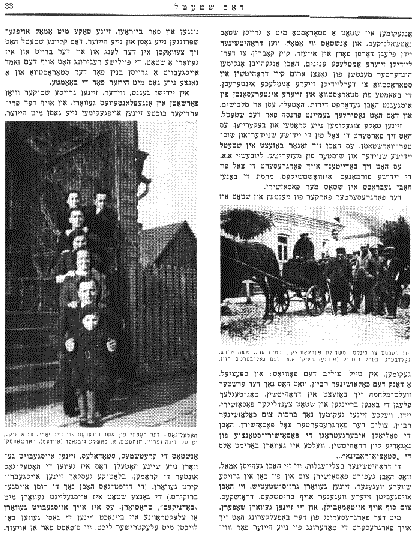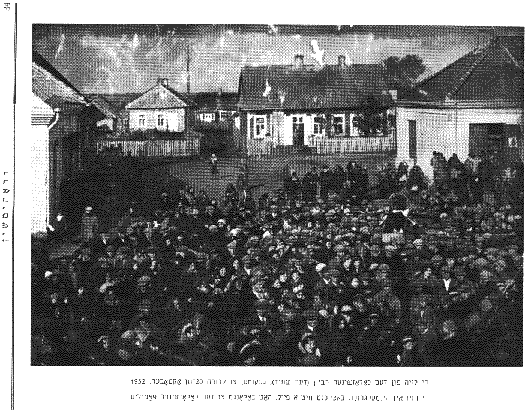 [Page 33]
[Page 33]
came to town with a large staff of bureaucrats. Unlike earlier times, when Jews had to travel to the district center of Kobrin to deal with their tax issues, hundreds of people now started coming to the municipal offices in Drohitchin to deal with their tax issues. The municipal officials and the people from the surrounding areas needed places to stay, hotels, food and clothing. This of course, brought money into town.
New stores and bakeries opened, and the number of Jewish tailor and shoemaker shops increased, and Jewish tailors and shoemakers from Mezeritch, Lyubeshei and other places moved to Drohitichin. The situation caused an increase in the number of Jewish foremen and drivers because the roads carried along more travelers.
[Photo:] From right to left: Moshele Perkovsky, Steinberg, Moshe Porush, Goldberg, Berl Resnick (driver), and others next to Goldberg's house.
The increased traffic of people into town was partly due to the district offices, especially to the Kholozshin Rebbe, who settled in Drohitchin after World War I. Every single day, the roads carried dozens of travelers into town – Jews who came to receive blessings from the Kholozshin Rebbe. Due to the increase in travelers, the Poles moved the train station, known as the Stantsia-Ravina station to Drohitchin from Nagoria.
The coachmen who drove passengers back and forth on the road in large heavy wagons became urbane; they exchanged their wagons for horse-drawn carriages and ultimately, automobiles, becoming chauffeurs.
As the population increased, the demand for new homes and offices also increased. Suddenly new roads and houses sprung up in town. The little shtetl starting growing in all directions, and became a city. The Polish government built a large municipal building, as well as a brand new road and houses for city employees.
Large parts of the Vion were cleared and new roads and houses were built in the area of the former bay.
[Photo:] Hotel Street: The hotel of Asher Siderov and his family – grandson Yossek, Dina (wife), Chanatshe A. Bashka Gibgold (son-in-law), Warshavsky.
Instead of stores and stalls, fine new hotels were built, and the street was known for its hotels rather than shops. The small dirt alleys were now paved (the Russians had earlier paved the main road). The entire town was equipped with sidewalks, and an electricity station was built, which provided electric lights on the streets, just like in any other district center.



